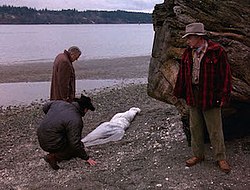Critical reception
Initially, the show's Thursday night time slot was not a good one for soap operas as both Dynasty and its short-lived spin-off The Colbys did poorly. [19] Twin Peaks was also up against the hugely successful sitcom Cheers . But the show received an initial positive response from TV critics. Tom Shales, in The Washington Post , wrote: "Twin Peaks disorients you in ways that small-screen productions seldom attempt. It's a pleasurable sensation, the floor dropping out and leaving one dangling." [24] In The New York Times , John J. O'Connor wrote: "Twin Peaks is not a sendup of the form. Mr. Lynch clearly savors the standard ingredients...but then the director adds his own peculiar touches, small passing details that suddenly, and often hilariously, thrust the commonplace out of kilter." [25]
Many critics saw the pilot as "the movie that will change TV" history, according to Diana White from The Boston Globe . [26] Ken Tucker from Entertainment Weekly was strongly positive about the episode, giving it a A+. While liking the story, and calling Lynch's directing beautiful, he said "[there is] not a chance in hell" the show could become a ratings hit, because of its "unsettling" story. [27] David Zurawik from The Baltimore Sun compared the pilot to the work of Alfred Hitchcock. He also said its cinematography was "about as close as prime-time television gets to art." [28] Jen Chaney from The Washington Post called the pilot "one of the most finely crafted series kick-offs in broadcast history". [29]
In 1997, TV Guide ranked the pilot #25 on its list of the 100 Greatest Episodes. [30] In 2013, it was mentioned in the WGA's list of the 101 best written TV series where Twin Peaks came 35. [31] In 2024, Rolling Stone listed it as the 13th best TV episode of all time. [32]
Michael Ontkean later recalled,
Paul Newman, who was my friend, missed the broadcast of the original Twin Peaks pilot on television and was well aware of the avalanche of positive reviews. I called David [Lynch] and asked for a copy to be sent to us in New York. Paul arranged for it to be shown at a Manhattan screening room. It was just the two of us and Mike Nichols. Afterwards, Paul gathered himself, got real quiet, turned to me and said it was one of the few times in his life he had experienced a perfect movie. [33]

